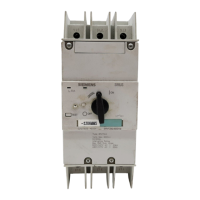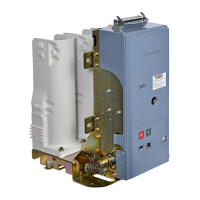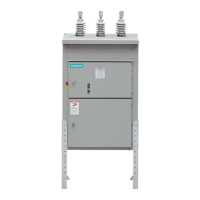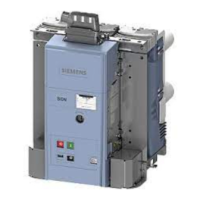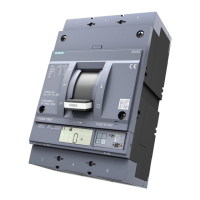Testing
On models with
targets the
Overload target should indicate
when
tripping
occurs,
Note: While
timing
out at values slightly above
pick-up
with
the
"Thermal
Memory"
switch
"Out,"
normal variations in
supply
voltage may
cause the
device to drop out momentarily
and
cause the timing
to be interrupted. lt is recommended
that the
pickup
LED
be monitored
throughout the
test.
Also, for
the
same reason,
attempting
to test Long Time timing
at
less
than
20
percent
above
the current setting may not
be successful.
Thermal
Memory Test
The
"Thermal
Memory"
function accumulates
the Long Time
signal and
provides
a cool down function for
the
Long Time
delay.
Switching the thermal memory
"Out"
disables the inte-
grator
and allows
the long time delay
elements to reset when
ever the
long
time
signal drops below
pickup.
When
the
"Thermal
Memory"
swrtch is
"ln"
the long time delay
elements
are not reset when
the signal
drops below
pickup,
but are
decreased slowly with
time.
To
check the
operation of the circuit,
set
Long
Time Current
Setting on ,5, Long Time Delay
on 3.5 and move
the
"Thermal
Memory"
switch to
"1n."
Make
sure the switch
above the
LED
timer readout
on the PTS4 is set to
"Static
Trip
lll Long Time."
Apply .55
amperes
to one
phase
input and
allow the device to
time
out.
Record
the
time.
Move
the
"Thermal
Memory"
switch
to
"Out,"
repeat
the same
test and
record
the time. lt should
be
the same as the first
test.
Now
move the
"Thermal
Memory"
switch back to
"1n."
Repeat
the
test, but this time momentarily
lower the current
every
10
seconds
to 0,2 ampere for
approximately 3 seconds
until the
long
time
pickup
LED
goes
out. Be very
careful to not drop
below 0.15 amperes. Again,
measure and record
tripping
time.
This
should be
approximately the same
as
for
the
f irst
two
tests. Move
the
"Thermal
Memory"
switch to the
"Out"
position
and repeat
this test. ln this
case the device should never time
out and it
should be
possible
to continue the cycle indef initely.
Short
Time
Delay Test
To test, set lnstantaneous
to its maximum
and move the small
selector switch labeled
Short Time l2t
to
"Out,"
Move the switch
above the LED timer readout
on the PTS4
to
"All
Other
Tests"
and
select the
phase
to be tested, Set Long Time
Current
Setting on .5
Short Time Pickup
on
2X,
set the PTS4 test set
current source for 21o
3 amperes,
close the breaker and apply
the
current.
The
breaker
should trip within the Iimits
of the Short
Time Band
selected.
On
modeis
with Targets
the Short
Circuittarget should operate,
On
models
with Zone
lnterlocking the
time delay will be
approximately
0.1 second with
the Zone lnterlock
switch
"1n."
The
operation
of the Short Time l2t ramp
can be checked by
supplying 1.5
amperes to the device. Repeat
the test to
measure
the time delay. Move
the Short Time l2t ramp
switch
to the
"
ln"
position,
and repeat
the test at the same current. The
delay should be long with
the switch
"1n."
Ground
Time Delay Test
The
Ground time delay can be tested similar to the Short
Time
delay test. When the tripping
output appears, the Ground
Fault
target appears.
Zone lnterlock Test
On devices with the Zone lnterlock
option, both the Short
Time
and the Ground time delay bands are affected bythe incoming
Zl signal. With no incoming
Zl signal both time delay bands
will
be on
their
minimum. When
an incoming Zl signal
is
present
both the
ShortTime and Ground delay elements operate on
the
band selected
by the
front
panel
controls.
On devices containing the Zl function, Ihe Zl output circuit
provides
an output signal anytime either the Short
Time
or
Ground
pickup
values
are exceeded.
Both the incoming and outgoing Zl
circuits are
isolated by an
optical isolator inside the device, so some
power
must be
provided
to the trip devices, as in normal operation,
Both
sets of signals are brought out the
l5
pin
connector.
Terminal numbering is from 1
through
15.
Pin
I and 2 arelhe device negative
power.
Pin
3
is
the device +12 volt
power
Pin 4 is
the
+5 volts from
the target
power
supply
Pin
5 is the Zl
positive
signal
input
Pin 6 is the Zl negative
signal
input
Pin 7 is
the
Zl negative
signal output
Pin 8 is
the
Zl
positive
signal output
The signals from the 15
pin
connector are connected together
into
a Zone lnterlocking
System
through a Zone lnterlock
Coupler and/or
Zone Interlock
Expander mounted in the breaker
cubicle.
To check the operation of
lhe
Zl i n
put
ci
rcuit,
set
the
Short
Time
and Ground time delay
bands above
minimum
band
so that
a difference
in
timing can be detected. Move the Short Time
l2t
switch to the
"out"
position
and Zone Interlock switch to the
"ln"
position.
Run
the time delay test as described
pre-
viously.
The measured times should correspond to the mini-
mum
time delay,
regardless
of setting, Now
plug
the Zl signal
tester
(18-732-790-563)
into
the
15-pin
connector on the
front
of the trip unit. The LED
on the
Zl
tester
indicates when
an
outgoing Zl signal is
present,
and should
Iight whenever
Short
Time
or Ground
Pickup
occurs, The smalltoggle switch on the
Zl tester
can be used to activate an incoming Zl signal to the
trip unit. With the incoming Zl
blocking signal switched
on, the
measured
delay should correspond
to the
time
delay
setting,
not the minimum
delay.
lf the short time l2t
switch
is
"ln,"
the
incoming Zl
signal
will not
change the time delay
unless the current used
in
the test
is
above the
range
where the l'?t ramp
circuits affect the
delay.
31
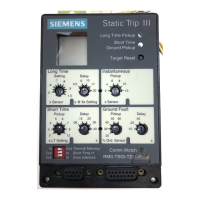
